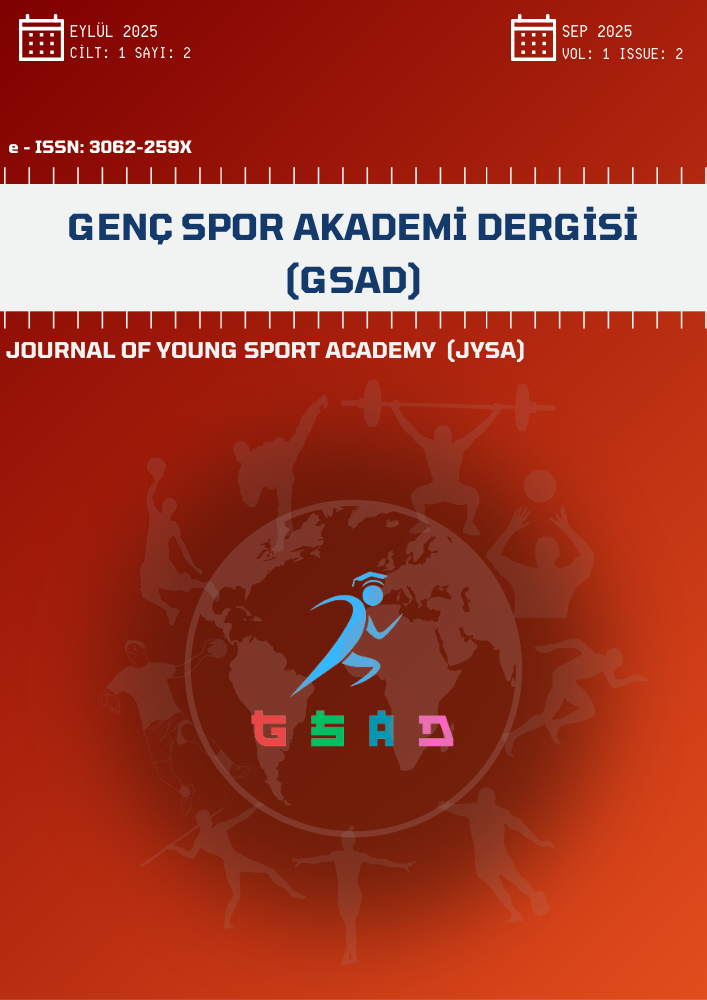The Relationship Between Emotional Intelligence Levels and State-Trait Anxiety Levels of Students in the Faculty of Sport Sciences
DOI:
https://doi.org/10.5281/zenodo.17041500Keywords:
Sport, Emotional Intelligance, AnxietyAbstract
The aim of this study is to examine the relationship between emotional intelligence levels and state-trait anxiety levels among students of the Faculty of Sport Sciences. This research is based on a quantitative research design, and the sample consists of 214 students enrolled in the Faculty of Sport Sciences at a public university in Türkiye. Data were collected using the Emotional Intelligence Scale and the State-Trait Anxiety Inventory (STAI). Pearson correlation and simple linear regression analyses were employed in the statistical analysis.The findings revealed weak and non-significant relationships between emotional intelligence and both state anxiety (r = –.012; p > .05) and trait anxiety (r = .076; p > .05). However, the sub-dimensions of emotional expression and utilization of emotions were found to be positively and significantly associated with both state and trait anxiety. Moreover, the results of the regression analysis indicated that emotional intelligence significantly predicted state anxiety (β = .214; p = .001), explaining 5.3% of the total variance (R² = .053). Emotional intelligence had a stronger and more significant predictive effect on trait anxiety (β = .284; p < .001), accounting for approximately 9.8% of the variance (R² = .098).These findings suggest that emotional intelligence is a significant predictor of anxiety levels among students and highlight the importance of developing emotional skills to promote psychological well-being in students engaged in sports-related academic programs.
References
Altın, M., Bozgüney, R., Üzgü, M. A., & Denktaş, M. (2022). Beden eğitimi ve spor yüksekokulları (BESYO) ve spor bilimleri fakülteleri (SBF) özel yetenek sınavlarının incelenmesi ve değerlendirilmesi. Gençlik Araştırmaları Dergisi, 10(28), 131-154.
Altın, M., Kıvrak, A. O., Temür, E., Tarman, B., Serdar, K., Denktaş, M., ... & Bozgüney, R. (2019). Fair-play behavior of high school students playing futsal and football. The Journal of Eurasia Sport Sciences and Medicine, 1(1), 46-56.
Barlow, D. H. (2002). Anxiety and its disorders: The nature and treatment of anxiety and panic (2nd ed.). Guilford Press.
Bozgüney, R. (2021). Rekreasyon bölümünün yönetim düzeyinde ve özgünlükleri arasındaki ilişkinin incelenmesi (Yüksek Lisans tezi, Necmettin Erbakan Üniversitesi (Türkiye)).
Bozgüney, R., & Can, B. (2023). Examination of smoking addiction according to some variables in sports sciences faculty students. KOSALB International Journal of Human Movements Science, 2(1), 48-53
Bozgüney, R., & Çimen, E. (2024). Spor bilimleri fakültesinde öğrenim gören öğrencilerin geleceğe yönelik tutum ve içsel motivasyonları arasındaki ilişkinin incelenmesi. SOCIAL SCIENCES STUDIES JOURNAL (SSSJournal), 9(117), 9288-9294.
Brackett, M. A., & Rivers, S. E. (2014). Transforming students’ lives with social and emotional learning. International Handbook of Emotions in Education, 368–388.
Carver, C. S., Scheier, M. F., & Segerstrom, S. C. (2010). Optimism. Clinical Psychology Review, 30(7), 879–889.
Çimen, E., Bozgüney, R., & Çiçeksöğüt, R. (2023). Spor bilimleri fakültesinde öğrenim gören öğrencilerin zihinsel antrenman becerisi ile bilinçli farkındalık düzeyleri arasındaki ilişkinin incelenmesi. Çanakkale Onsekiz Mart Üniversitesi Spor Bilimleri Dergisi, 6(4), 42-52.
Extremera, N., & Fernández-Berrocal, P. (2005). Perceived emotional intelligence and life satisfaction: Predictive and incremental validity using the Trait Meta-Mood Scale. Personality and Individual Differences, 39(5), 937–948. https://doi.org/10.1016/j.paid.2005.03.012
Goleman, D. (1995). Emotional intelligence: Why it can matter more than IQ. Bantam Books.
Gross, J. J. (2015). Emotion regulation: Current status and future prospects. Psychological Inquiry, 26(1), 1–26.
Karasar, N. (2022). Bilimsel araştırma yöntemi: Kavramlar, İlkeler, Teknikler. Nobel Yayın Dağıtım. Ankara.
Petrides, K. V., Pita, R., & Kokkinaki, F. (2007). The location of trait emotional intelligence in personality factor space. British Journal of Psychology, 98(2), 273–289.
Salovey, P., & Mayer, J. D. (1990). Emotional intelligence. Imagination, Cognition and Personality, 9(3), 185–211. https://doi.org/10.2190/DUGG-P24E-52WK-6CDG
Salovey, P., & Mayer, J. D. (1990). Emotional intelligence. Imagination, Cognition and Personality, 9(3), 185–211.
Schutte, N. S., Malouff, J. M., Hall, L. E., Haggerty, D. J., Cooper, J. T., Golden, C. J., & Dornheim, L. (2002). Development and validation of a measure of emotional intelligence. Personality and Individual Differences, 25(2), 167–177. https://doi.org/10.1016/S0191-8869(98)00001-4
Spielberger, C. D., Gorsuch, R. L., & Lushene, R. E. (1983). Manual for the State-Trait Anxiety Inventory (STAI). Consulting Psychologists Press.
Tabachnick, BG ve Fidell, LS (2007). ANOVA kullanan deneysel tasarımlar (Cilt 724). Belmont, CA: Thomson/Brooks/Cole.
Zeidner, M., Matthews, G., & Roberts, R. D. (2009). What we know about emotional intelligence: How it affects learning, work, relationships, and our mental health. MIT Press.
Zeidner, M., Matthews, G., & Roberts, R. D. (2012). The emotional intelligence, health, and well-being nexus: What have we learned and what have we missed? Applied Psychology: Health and Well-Being, 4(1), 1–30. https://doi.org/10.1111/j.1758-0854.2011.01062.x
Downloads
Published
How to Cite
Issue
Section
License
Copyright (c) 2025 Banu Can

This work is licensed under a Creative Commons Attribution-NonCommercial 4.0 International License.


